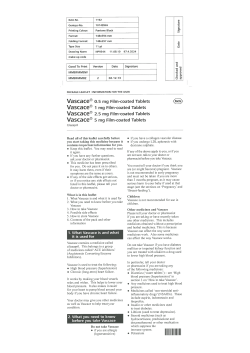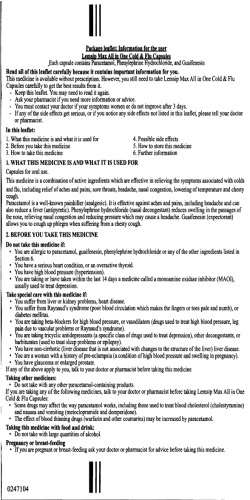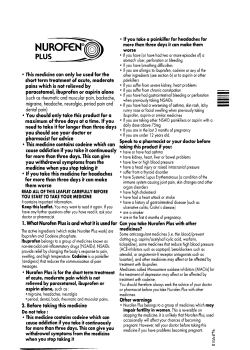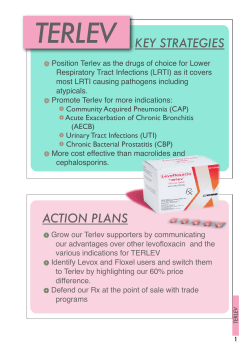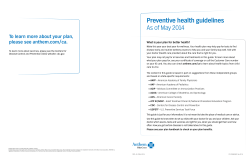
Amoxicillin 125mg/5ml & 250mg/5ml Oral Suspension
PATIENT INFORMATION LEAFLET
Amoxicillin 125mg/5ml & 250mg/5ml Oral Suspension
Please read this leaflet carefully before you start to take your medicine.
Keep this leaflet. You may need to read it again.
If you have further questions, please ask your doctor or your pharmacist.
This medicine has been prescribed for you personally and you should not pass it on
to others. It may harm them even if their symptoms are the same as yours.
If any of the side effects get serious, or if you notice any side effects not listed in the
leaflet, please tell your doctor or pharmacist.
1.
2.
3.
4.
5.
6.
What your medicine is and what it is used for
Before you take your medicine
How to take your medicine
Possible side effects
How to store your medicine
Further information
1. WHAT YOUR MEDICINE IS AND WHAT IT IS USED FOR
Amoxicillin is one of a
group of antibiotic medicines called penicillins. Amoxicillin works by interfering with the
bacteria that cause the infection.
Amoxicillin can treat a wide range of infections including:
chest (bronchitis or pneumonia)
tonsils (tonsillitis)
ears (otitis media)
sinuses (sinusitis)
kidneys
heart (endocarditis)
blood (septicaemia)
the bladder or the urethra (the tube which carries urine from the bladder)
the female reproductive system including infections associated with pregnancy and
childbirth (puerperal sepsis and septic abortion)
abdomen (intra-abdominal sepsis and peritonitis)
skin, bone, teeth and gums (abscesses)
gonorrhoea (a sexually transmitted infection)
typhoid and paratyphoid (fevers caused by a group of bacteria called Salmonella)
2. BEFORE YOU TAKE YOUR MEDICINE
Do not take this medicine and consult your doctor if the answer to any of the following is yes
(for you/your child):
You have ever had a bad reaction or allergy to any penicillin-type antibiotic
You have ever had a skin rash or swelling of the face or neck or shortness of breath when
taking any antibiotic
You are allergic to any of the ingredients contained in this medicine
Take special care with your medicine
Check with your doctor or pharmacist before taking this medicine if:
You suffer from kidney problems, as you may require a lower dose than normal
You have glandular fever, cytomegalovirus (CMV) infection or certain types of
leukaemia - you may be at greater risk of developing a rash when you take this medicine
You have an intolerance to some sugars or have diabetes mellitus, as this medicine
contains sucrose.
Taking other medicines
Check with your doctor or pharmacist if you are taking, or have recently taken any other
medicines even those not prescribed by a doctor. In particular tell your doctor if you are taking
any of the following;
The contraceptive pill (in which case you will have to take extra contraceptive measures
such as using a condom)
Anticoagulants e.g. warfarin, phenindione
Chemotherapy drugs e.g. methotrexate
Drugs used to treat gout (which can be caused by the build up of uric acid) e.g.
probenecid, allopurinol, sulfinpyrazone
Some other antibiotics (e.g. neomycin and tetracyclines can reduce the effect of
amoxicillin)
Oral typhoid vaccine (may not work if taken with amoxicillin)
Some penicillins may increase the effects of muscle relaxing drugs given as part of an
anaesthetic for surgery. Tell the doctor you are taking amoxicillin if you need to have an
anaesthetic.
Having urine or blood tests
If you or your child are having urine tests for diabetes (sugar in the urine), or blood tests for liver
function let the doctor know. Amoxicillin can affect the results of these tests.
Pregnancy and breast-feeding
Check with your doctor before you take this medicine if you are pregnant or breast-feeding.
Important information about some of the ingredients in your medicine
Amoxicillin 250mg/5ml Oral Suspension contains 2.72g of sucrose per 5ml, Amoxicillin
125mg/5ml Oral Suspension contains 2.68g of sucrose per 5ml.
This should be taken into account in patients with diabetes mellitus.
If you have been told by your doctor that you have an intolerance to some sugars, contact
your doctor before taking this medicinal product.
3. HOW TO TAKE YOUR MEDICINE
Follow all directions given to you by your doctor or pharmacist. Their directions may differ from
the information contained in this leaflet. Your doctor may advise you to take your medicine in a
different way, so you should always follow your doctor's advice about when and how to take
your medicine and always read the label. Your pharmacist may be able to help if you are not
sure.
You may give/take amoxicillin before, with or after food. Space the doses as evenly as possible
throughout the day. You should make sure you/your child have several more drinks of water
each day unless told otherwise by your doctor.
Dosage
Note: One teaspoon is equivalent to 5ml
Adults (including the elderly):
The maximum daily dose should not be more than 6g per day in total.
The usual dose for most infections is 5ml of 250mg/5ml to be taken 3 times a day.
For more serious infections the dose may be doubled to 10ml of 250mg/5ml 3 times a
day.
The following doses may be given in the following conditions:
- Severe or recurrent chest infections: 3 g twice daily
- Simple urinary tract infections: two 3g doses with 10 to 12 hours between doses
(short course)
- Dental abscesses: two 3g doses with 8 hours between doses
- Gonorrhoea: a single 3g dose
The following are the usual adult dosages for preventing infection during dental or other
surgery:
- If a general anaesthetic is not used, 3g one hour before surgery and another dose six
hours later if necessary
- If a general anaesthetic is used, 3g four hours before anaesthesia and 3g six hours
after the initial dose
Children:
The maximum daily dose should not be more than 3g per day in total.
Children weighing more than 40kg should be given the usual adult dosage
Children weighing less than 40kg:
- All doses are worked out depending on the child’s body weight in kilograms. Your
doctor will advise you how much medicine you should give to your baby or child.
The usual dose is 40mg to 90mg for each kilogram of body weight a day, given in
two or three divided doses.
If you take more of your medicine than you should
If you (or somebody else) accidentally take too much of your medicine, speak to your doctor or
pharmacist immediately. You should take this leaflet and any medicine you still have to show the
doctor.
Severe cases of nausea, vomiting and diarrhoea can be treated with rehydration therapy, by
drinking fluids containing sodium, water and sugar to prevent dehydration.
If you forget to take your medicine
If you forget to take a dose, take it as soon as you remember, unless it is within an hour of your
next dose, then carry on as before. Do not take a double dose to make up for the dose you have
missed.
If you stop taking your medicine
Keep taking this medicine until it is finished or your doctor tells you to stop. Do not stop taking
it just because you feel better. If you stop taking the medicine, some bacteria may survive and
cause the infection to come back, or your condition may re-occur or get worse.
If you/your child are still unwell after taking all the medicine, go and see your doctor. Never
give/take more than the recommended dose each day.
4. POSSIBLE SIDE EFFECTS
As with all medicines, some people may experience side effects with amoxicillin.
If you experience any of the following events STOP taking your medicine, tell your doctor
or go to your nearest hospital immediately:
Hypersensitivity or severe allergic reaction including swollen face or breathing problems
Severe diarrhoea with bleeding
Allergic skin reactions with itching e.g. hives, nettle rash, blistering or peeling of the
skin. If you start to itch or get a rash, STOP taking amoxicillin and tell your doctor
immediately.
Convulsions may occur in patients on high doses or with kidney problems
Notice your urine becoming darker or your faeces becoming paler
Notice your skin or the white of your eyes turning yellow (jaundice)
Difficulty or discomfort in passing urine or having cloudy urine
The following symptoms are less serious but you may wish to discuss them with your
doctor or pharmacist if they become troublesome or last a long time.
Common side effects (i.e. more than 1 in 100 people):
Nausea (feeling sick) or diarrhoea
Uncommon side effects (i.e. between 1 in 100 and 1 in 1,000 people):
Vomiting
Very rare side effects (i.e. less than 1 in 10,000 people):
Thrush (a yeast infection of the vagina, mouth or skin folds). You can get treatment for
thrush from your doctor or pharmacist.
Tooth discolouration. The colour usually returns to normal with brushing.
Blackening of the tongue
Inflammation of the kidney
Excessive body movements (hyperkinesia) or dizziness
Reduction (reversible) in blood cell counts including anaemia (a reduction in the body’s
red blood cells or haemoglobin which may be characterised by feeling weak or lightheaded) or a longer time taken for blood to clot.
Crystalluria, forming of crystals in the urine
If you notice any side effects not mentioned in this leaflet please inform your doctor or
pharmacist.
5. HOW TO STORE YOUR MEDICINE
Do not use your medicine after the expiry date shown on the label. The expiry date to be
followed is that included by the pharmacist after the medicine is made up for you.
Protect from light.
Dry powder: Store in a dry place below 25°C.
Reconstituted suspension: Store for 7 days at 2°C-8°C in a refrigerator.
KEEP OUT OF THE REACH AND SIGHT OF CHILDREN
If your doctor tells you to stop your treatment, return any left over to the pharmacist. Only keep
it if your doctor tells you to. Medicines should not be disposed of via wastewater or household
waste. Ask your pharmacist how to dispose of medicines no longer required. These measures
will help protect the environment.
6. FURTHER INFORMATION
What your medicine contains
Each 5ml spoonful of Amoxicillin 125mg/5ml or 250mg/5ml Oral Suspension contains either
125 mg or 250 mg of amoxicillin as amoxicillin trihydrate. Each bottle also contains sodium
benzoate (E211), disodium edetate, sodium citrate anhydrous, lemon flavour powder, quinoline
yellow (E104) and sucrose.
What your medicine looks like and contents of the pack
Amoxicillin 125mg/5ml and 250mg/5ml Oral Suspension is available as a pale yellow granular
dry powder in a bottle for preparation of a yellow suspension with a lemon odour and flavour.
When prepared by the pharmacist, the 125mg/5ml bottle contains 100ml of suspension and the
250mg/5ml bottle contains 100ml of suspension.
The product is manufactured by
Athlone Laboratories Limited, Ballymurray, Co. Roscommon, Ireland.
The product licences are also held by Athlone Laboratories Limited.
The product is distributed by
Kent Pharmaceuticals Limited, Repton Road, Measham, DE12 7DT, U.K.
PL 06453/0021
PL 06453/0022
This leaflet was last revised in November 2011
PATIENT INFORMATION LEAFLET
Pinamox (Amoxicillin Oral Suspension BP) 125mg/5ml
Pinamox (Amoxicillin Oral Suspension BP) 250mg/5ml
Amoxicillin (as amoxicillin trihydrate)
Please read this leaflet carefully before you start to take your medicine.
Keep this leaflet. You may need to read it again.
If you have further questions, please ask your doctor or your pharmacist.
This medicine has been prescribed for you personally and you should not pass it on
to others. It may harm them even if their symptoms are the same as yours.
If you get any side effects, or if you notice any side effects not listed in the leaflet,
please tell your doctor or pharmacist.
IN THIS LEAFLET
1.
2.
3.
4.
5.
6.
What your medicine is and what it is used for
What you need to know before you take your medicine
How to take your medicine
Possible side effects
How to store your medicine
Contents of the pack and other information
1. WHAT YOUR MEDICINE IS AND WHAT IT IS USED FOR
The name of your medicine is Pinamox. It is a powder for oral suspension. When prepared by
the pharmacist, each bottle contains 100ml of suspension. Each 5ml spoonful of Pinamox
contains either 125mg or 250mg of amoxicillin as amoxicillin trihydrate. Amoxicillin is one
of a group of antibiotics called broad spectrum antibiotics. Pinamox is used to kill bacteria
which cause infections in your body.
Pinamox can also be used to treat
dental infections (abscesses)
gonorrhoea (a sexually transmitted infection)
prevent bacterial infections of the heart (bacterial endocarditis) following dental work
or other operations in patients who have heart conditions or artificial heart valves.
2. WHAT YOU NEED TO KNOW BEFORE YOU TAKE YOUR MEDICINE
Do not take Pinamox if you:
Have ever had a bad reaction or allergy to any penicillin-type antibiotic
Have ever had a skin rash, swelling of the face or neck, or shortness of breath when
taking any antibiotic
Are allergic to amoxicillin or any of the other ingredients contained in this medicine
(listed in section 6)
Warnings and precautions
Check with your doctor or pharmacist before taking Pinamox if you:
Suffer from kidney or liver problems
Are suffering from glandular fever
Are pregnant or breast-feeding, or planning pregnancy or breast-feeding
Are not passing water regularly
Have an intolerance to some sugars or have diabetes as this medicine contains sucrose
In newborn and premature babies, liver, kidney and blood functions should be closely
monitored.
Other medicines and Pinamox
Check with your doctor or pharmacist if you are taking, or have recently taken any other
medicines even those not prescribed by a doctor. In particular tell your doctor if you are
taking any of the following:
Anticoagulants (medicines used to prevent blood clots e.g. warfarin)
Drugs used to treat gout (which can be caused by the build up of uric acid) e.g.
probenecid, allopurinol or sulfinpyrazone
Some other antibiotics taken at the same time (e.g. tetracyclines, chloramphenicol,
sulfonamides and erythromycin) may affect the way Pinamox oral suspension works.
The contraceptive pill (in which case you will have to take extra contraceptive
measures such as using a condom)
Methotrexate (used to treat tumours), Crohn’s disease, psoriasis and rheumatoid
arthritis
Blood or urine tests
If you or your child are having urine tests e.g. for diabetes (sugar in the urine) or blood tests
e.g. for liver function let the doctor know that you or your child are taking Pinamox as
amoxicillin can affect the results of these tests.
Pregnancy and breast-feeding
Check with your doctor before you take this medicine if you are pregnant or breast-feeding.
Driving and using machines
This medicine is not likely to affect your ability to drive or operate machinery.
Pinamox contains sucrose
Pinamox (Amoxicillin Oral Suspension) 125mg/5ml and 250mg/5ml contain 2.7g of sucrose
per 5ml dose.
This should be taken into account in patients with diabetes mellitus.
If you have been told by your doctor that you have an intolerance to some sugars,
contact your doctor before taking this medicinal product.
Pinamox 250mg/5ml Oral Suspension contains 77.64 mg of sodium per maximum 3g dose
Pinamox 125mg/5ml Oral Suspension contains 90.96mg of sodium per maximum 3g dose.
The sodium content of your medicine is as follows:
125mg/5ml strength Oral Suspension – 0.165 mmol/5ml
250mg/5ml strength Oral Suspension – 0.281 mmol/5ml
To be taken into consideration by patients on a controlled sodium diet.
3. HOW TO TAKE YOUR MEDICINE
Follow all directions given to you by your doctor or pharmacist. Their directions may differ
from the information contained in this leaflet. Your doctor may advise you to take your
medicine in a different way, so you should always follow your doctor’s advice about when
and how to take your medicine and always read the label. Your pharmacist may be able to
help if you are not sure.
Pinamox can be taken with or without food.
Dosage
You should follow your doctor’s or prescriber’s directions on how to take this product.
Adults (including the elderly):
The total daily dose should not exceed 6g in total, given in divided doses.
The usual dose for most infections is 5ml of Pinamox 250mg/5ml Oral Suspension to be
taken 3 times a day.
For more serious infections the dose may be doubled to 10ml of Pinamox 250mg/5ml
Oral Suspension 3 times a day.
High doses may be given in the following conditions:
Severe or recurrent chest infections: 3g twice daily
Simple urinary tract infections: two 3g doses with 10 to 12 hours between doses
(short course)
Dental abscesses: two 3g doses with 8 hours between doses
Gonorrhoea: a single 3g dose
The following are the usual adult dosages for preventing infection during dental or
other surgery:
3g Pinamox orally, 1 hour before procedure. A second dose may be given 6 hours later, if
considered necessary.
Children:
Children weighing more than 40kg should be given the usual adult dose
Children weighing less than 40kg:
The total daily dose should not exceed a total of 3g, given in divided doses.
All doses are worked out by your doctor and depend on your child’s body weight in
kilograms. The usual dose is 40mg – 90mg for each kilogram of body weight a day,
given in two or three divided doses.
The following is the usual children’s dosages for preventing infection during dental
procedures and other surgery:
50mg amoxicillin/kg body weight given as a single dose one hour preceding the surgical
procedure.
The following is the usual children’s dosages for treating tonsillitis:
Tonsillitis:50mg/kg/day in two divided doses
Patients with kidney problems
For patients with kidney problems, your doctor may prescribe a lower dose.
If you take more of your medicine than you should
If you take more medicine than you should, tell your doctor immediately or go to the nearest
hospital. You should take this leaflet and any medicine you still have to show the doctor.
Severe cases of nausea, vomiting, and diarrhoea can be treated with rehydration therapy, by
drinking fluids containing sodium, water and glucose to prevent dehydration, contact your
doctor or pharmacist for further advice.
If you forget to take your medicine
If you forget to take a dose, take it as soon as you remember, unless it is within an hour of
your next dose; then carry on as before. Do not take a double dose to make up for the dose
you have missed.
If you stop taking your medicine
Keep taking this medicine until your doctor tells you to stop. Do not stop taking it just
because you feel better. If you stop taking the medicine some bacteria may survive and cause
the infection to come back or your condition may reoccur or get worse.
If you still feel unwell at the end of your course of treatment, tell your doctor.
4. POSSIBLE SIDE EFFECTS
As with all medicines, some people may experience side effects with Pinamox.
If you experience any of the following events STOP taking your medicine and tell your
doctor or go to your nearest hospital immediately:
Hypersensitivity or severe allergic reaction including swollen face or breathing
problems. If these symptoms occur, STOP taking Pinamox right away and tell your
doctor.
Stevens-Johnson syndrome (a serious illness signs of which may include blistering of
the skin, mouth, eyes and genitals).
Toxic epidermal necrolysis (a serious illness signs of which may include blistering of
the skin).
Allergic skin reactions with itching e.g. ‘hives’ or ‘nettle rash.’ If you start to itch or
get a rash, STOP taking Pinamox and tell your doctor immediately.
Severe diarrhoea possibly with bleeding (pseudomembranous colitis)
Convulsions
Notice your skin or the whites of your eyes turning yellow (jaundice), hepatitis
(inflammation of the liver)
Difficulty or discomfort in passing urine or having blood in the urine
The following symptoms are less serious but you may wish to discuss them with your
doctor if they become troublesome or last a long time.
Common side effects (i.e. have been reported in more than 1 in 100 people):
Nausea (feeling sick) or diarrhoea
Uncommon side effects (i.e. have been reported in between 1 in 100 and 1 in 1,000
people):
Vomiting
Very rare side effects (i.e. reported in less than 1 in 10,000 people):
Thrush (a yeast infection of the vagina, mouth or skin folds). You can get treatment
for thrush from your doctor or pharmacist.
Tooth discolouration. The colour usually returns to normal with brushing.
Blackening of the tongue
Excessive body movements (hyperkinesia) or dizziness
Reduction (reversible) in blood cell counts that may result in anaemia (may be
characterised by feeling weak or light-headed); or a longer time taken for blood to
clot; or being more susceptible to infections
Crystalluria, forming of crystals in the urine
Change in liver enzymes
Urine becoming darker or faeces becoming paler
Meningitis (signs may include stiff neck, fever and vomiting)
If you notice any side effects not mentioned in this leaflet, or if you suffer from any of the
side effects listed please inform your doctor or pharmacist.
5. HOW TO STORE YOUR MEDICINE
Do not use your medicine after the expiry date which is stated on the label {after
abbreviation e.g. EXP.}. The expiry date refers to the last day of that month.
Dry powder: Store in a dry place below 25°C. Store in the original container.
Reconstituted suspension: Store for 7 days at 2°C-8°C in a refrigerator.
KEEP ALL MEDICINES OUT OF THE REACH AND SIGHT OF CHILDREN.
If your doctor tells you to stop your treatment, return any left over to the pharmacist. Only
keep it if your doctor tells you to.
Do not throw away any medicines via wastewater or household waste. Ask your pharmacist
how to throw away medicines you no longer use. These measures will help to protect the
environment.
6. CONTENTS OF THE PACK AND OTHER INFORMATION
What your medicine contains
Each 5ml spoonful of Pinamox (Amoxicillin Oral Suspension BP) contains either 125 mg
or 250 mg of amoxicillin as amoxicillin trihydrate. Each bottle also contains sodium
benzoate (E211), disodium edetate, sodium citrate anhydrous, lemon flavour powder,
quinoline yellow (E104) and sucrose.
The sodium content of your medicine is as follows:
125mg/5ml strength Oral Suspension – 0.165 mmol/5ml
250mg/5ml strength Oral Suspension – 0.281 mmol/5ml
What your medicine looks like and the contents of the pack
Your medicine comes in a bottle containing a pale yellow powder with the odour and
flavour of lemon. The 125mg/5ml strength is available in bottles containing either 60ml or
100ml of suspension as prepared by the pharmacist. The 250mg/5ml strength is available in
bottles containing 100ml of suspension as prepared by the pharmacist.
Not all pack sizes may be marketed.
The product is made by:
Your medicine is manufactured by Athlone Laboratories Limited, Ballymurray, Co.
Roscommon, Ireland.
The marketing authorisations are also held by Athlone Laboratories Limited.
The product is distributed by:
Pinewood Laboratories Ltd., Ballymacarbry, Clonmel, Co. Tipperary, Ireland.
PA Number: PA 298/10/1 – Pinamox (Amoxicillin Oral Suspension BP) 125mg/5ml
PA Number: PA 298/10/2 – Pinamox (Amoxicillin Oral Suspension BP) 250mg/5ml
Date of last revision December 2012
© Copyright 2025



